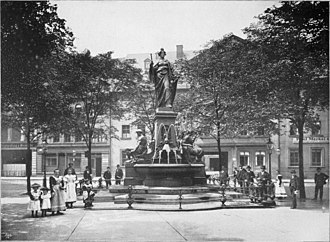Saxonia Fountain
| Saxonia Fountain | |
|---|---|
| Historical view of the fountain | |
| place | Chemnitz , Saxony |
| country |
|
| use | Art fountain |
| architect | Hans Pätzel |
| Technical specifications | |
| Building material | Bronze and granite |
| Coordinates | |
| location | Coordinates: 50 ° 49 ′ 59.5 " N , 12 ° 55 ′ 24.4" E 50 ° 49 ′ 59.5 " N , 12 ° 55 ′ 24.4" E |
The Saxonia Fountain , which once adorned the Chemnitz Roßmarkt , has been on the newly designed Johannisplatz since the beginning of July 2011 . The existing base and the top have been restored. The side bronze figures blacksmith and spinner, as well as the figure of Saxonia, who fell victim to a metal donation in the war, were replenished with donations. Instead of the previous two-tier base, the fountain was placed on a single-tier base during the reconstruction. According to the chairman of the Saxonia Fountain Association, Peter Fritzsche, the former fence was intentionally left out during the reconstruction so that one can approach the fountain and experience it more consciously. The newly cast “Saxonia” is considerably smaller than the original and somewhat simplified in design. For example, the large Saxon coat of arms, which previously explicitly identified the figure as a personification of Saxony, is missing.
history
The Saxonia Fountain owes its creation primarily to the Chemnitz Beautification Association . With the support of the Academic Council in Dresden and with funds from the State Art Fund, it was built and unveiled on July 9, 1893 at the Chemnitz Roßmarkt. The fountain consisted of a three-tiered base with the fountain basin and the high pedestal with a bronze figure of Saxonia - as the protector of industry and trade. The base is made of red Swedish granite . Spinner and blacksmith, the two bronze sculptures on the side symbolized the textile industry and mechanical engineering of Chemnitz. The designs and models for the fountain came from the architect Hans Pätzel and the sculptor Bruno Fischer from Dresden, the basin and the dolphin sculptures on the front and back by the Dresden sculptor Albert Ohlendieck .
Of the fountain, whose bronze figures fell victim to a metal donation in 1941, only the base and the top have survived. The remaining stone elements were stored in the municipal building yard at the suggestion of city building councilor Fred Otto . The dismantled bronze figures, weighing 2,410 kilograms, were sent to Breslau to be melted down on April 5, 1941 .
In 2011, investor Claus Kellnberger had the fountain in the Ore Mountains restored at his own expense and installed on Johannisplatz at the beginning of July. The bronze figures that were destroyed in the war were reproduced as closely as possible based on old photos and replicated in Poland by the artists Agnieszka Piechnik and Przemek Wolny and placed on the plinth again on July 11, 2013. The inauguration took place on July 14, 2013.
Individual evidence
- ^ Wilhelm Zöllner: Chemnitz at the end of the XIX. Century in words and pictures . Chemnitz (Körner & Lauterbach) around 1900.
- ↑ J. Seyffarth: Letter to the editor on the article "Hope for Saxonia-Brunnen" from July 14, 2010. Chemnitz Free Press, July 2010
- ↑ Saxonia on the hook. Free Press, accessed July 12, 2013 .

